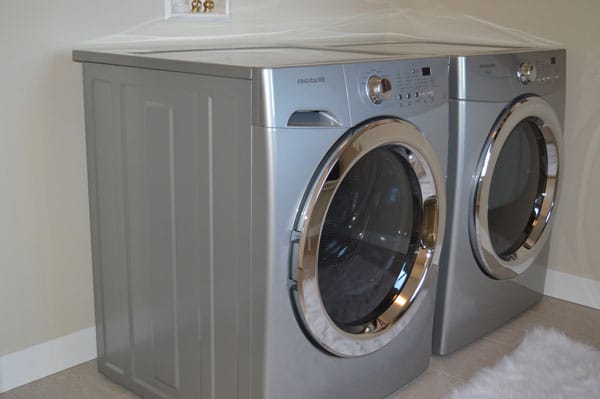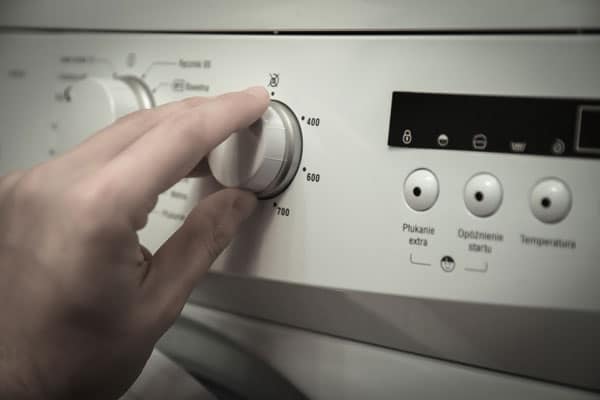Big and heavy, washing machines are quite difficult to move from one home to another. To make matters even more complicated, washers require a lot of pre-move preparation – you can’t just unplug the appliance and load it on the moving truck. Washing machines need to be disconnected from the water supply, drained completely, and equipped with transit bolts before they can be taken out of the home and transported to the new location.
All in all, moving a washing machine is a big challenge, so it’s best to leave the job to professional movers. If you have decided to move without professional moving help, however, you will need to find a way to overcome the challenge yourself and relocate your washer without causing any damage to it or to your property – and without getting injured in the process.
Here is how to move a washing machine in a safe and efficient manner:
How to prepare a washing machine for moving
When it comes to moving a washer, preparation is half the job – there is a lot to do to get your washing machine ready for moving and you need to do it the right way in order to ensure a safe and smooth relocation.
Get the necessary equipment and supplies
Washing machines are very heavy and their internal mechanisms are quite vulnerable to damage, so it will be impossible to handle your washer safely without the right equipment for the job.
To ensure the safety of your washing machine and reduce the risk of accidents during the move, you’re going to need:
- An appliance dolly – Washing machines weigh about 150-200 lbs. – so, you can’t just lift and carry your washer with your bare hands. You need a safe way to take the heavy appliance to the waiting moving truck – and an appliance dolly is your best choice. The sturdy, L-shaped dolly can withstand great weights and will allow you to safely and quickly wheel your heavy washer out of your home and load it into the moving truck (and the other way around upon arrival at your new place);
- Moving blankets – You may accidentally bump your washer into something when moving it around, one of your items may shift during transit and hit the appliance, etc. To protect your washing machine against scratches, dents, and other damage during the move, you need to wrap the appliance in padded moving blankets. Make sure you have some stretch wrap – or quality packing tape – too, so you can secure the protective coverings in place;
- Transit bolts – Washing machines should never be moved without properly installed transit bolts (metal rods that are inserted into the washer in order to keep the drum immobilized during transit) because the vibrations on the road can easily cause damage to the drum suspension mechanism. If you keep the shipping bolts your washing machine was initially delivered with, find them before you start preparing the appliance for moving. If not, go to the nearest home appliance store and see if they have the required bolts for your model;
- The instruction manual for your washing machine – There will be safety recommendations, instructions on how to properly install transit bolts on your washer, and other important information in the user’s manual, so you’re advised to consult it before the move. If you don’t have the instruction manual for your washing machine, you will most likely be able to find it online.
Before you get to work, make sure you have slip-joint pliers and a bucket close at hand.
Get the washer ready for moving
Once you’ve gathered everything necessary, you can start preparing your washing machine for moving:
- Remove any clothes from the washer;
- Run a short wash cycle with water only (or use the pre-set Clean Cycle) to clean the drum and the drain lines of the washing machine. Let the drum dry out completely;
- Turn off the washer and unplug it from the power outlet. Secure the power cord to the back of the appliance with a piece of tape.
Drain the washing machine
Draining the washer is the most crucial step in preparing the appliance for moving.
Here is how to drain a washing machine for moving the right way:
- Drain the water supply hose(s) – Your washer may have one water supply hose (if the appliance heats the water inside the unit) or two water supply hoses (one for hot water and one for cold water). If there is only one supply hose, disconnect it from the water supply with the help of slip-joint pliers and empty any remaining water into a bucket. If there are two supply hoses, disconnect only one hose at a time and empty it completely before disconnecting the other hose. When ready, use the slip-joint pliers to disconnect the supply hose(s) from the washing machine and place the detached hose(s) in a large sealable plastic bag;
- Empty the drain hose – The drain hose empties the dirty water from the washing machine into the wastewater discharge canal. Follow the drain hose to its discharge point, disconnect it from there, and empty any remaining water into a bucket. It is not a good idea to disconnect the drain hose from the washer, so secure it to the back of the appliance instead (use tape or stretch wrap).
Install the transit bolts
Last but not least, you need to install the transit bolts – remember that the drum suspension of the washer is very complex and very susceptible to damage, so it’s extremely important to install the shipping bolts properly.
The exact installation method depends on the specific model of your washing machine, so be sure to consult the instruction manual. Usually, though, there are two openings in the rear side of the washer – one for each bolt. All you need to do is carefully insert the rods in the openings and turn them slightly so they lock the drum in place.
Knowing how to disconnect a washing machine for moving correctly will save you a lot of headaches during your relocation – and knowing how to secure the drum will save you some costly repairs after the move.
All that remains now is to find out how to actually move the washer to your new home.
How to move a washing machine by yourself
The best way to move a washer is to load it on an appliance dolly, wheel it to the moving truck and up the ramp into the vehicle, secure it in place with ratchet straps, and transport it in an upright position to your new home:
- Load the washing machine onto the appliance dolly – Tilt the washer slightly backward so you can slide the bottom plate of the dolly underneath the appliance, make sure the washer is stable and well balanced on the dolly, and secure it in place with straps or ropes. Tilt the appliance dolly back on its wheels.
- Once the washing machine is disconnected and drained and the drum is properly secured, get the appliance away from the wall (use furniture sliders to make the task safer and easier) and wrap it completely in moving blankets (use tape or plastic wrap to keep the blankets in place).
- Carefully wheel the washer out of your home and to the moving truck.
- Load the washing machine into the moving truck – Wheel the washer up the loading ramp, into the moving vehicle. Once inside, get the appliance off the dolly, position it upright near one of the moving truck walls, and secure it in place with ratchet straps. (Can you transport a washer on its side? Washing machines should be transported in an upright position – it is risky to move a washer on its side as the drum may easily get damaged.)
- When you reach your new home, use the appliance dolly to unload the washing machine and take it to its rightful place in your new house or apartment. Level the appliance with the help of its leveling legs and remove the transit bolts. Put the water supply hoses in place and connect the washer to the water supply. Connect the drain hose to the water drain. Finally, connect the appliance to the power supply.
As you can see moving a washing machine is not an easy job – and disconnecting the appliance and setting it up properly in the new home is especially tricky. If you’re not up to the challenge, don’t hesitate to hire professional movers to help you with your washer – and with all your other household items. The experts have the technical know-how, rich experience, and specialized equipment to take proper care of your belongings and ensure your safe and smooth relocation experience. Good luck!










